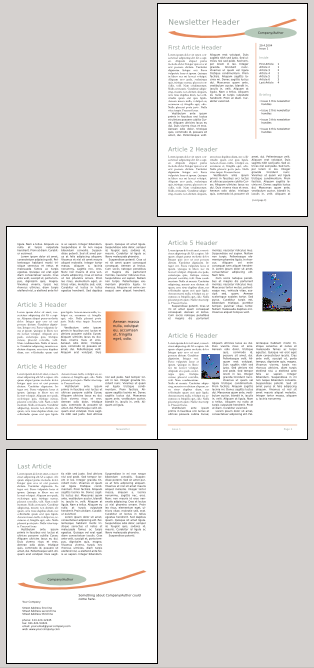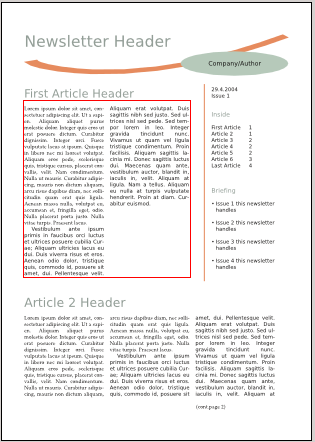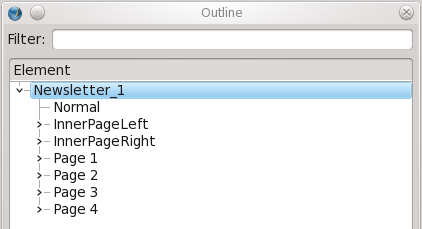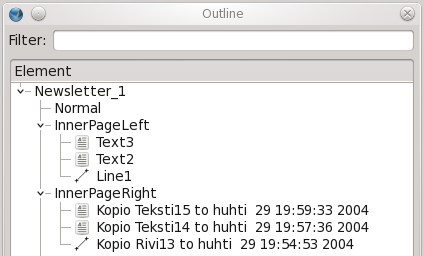The Outline Utility
Outline is something tucked underneath the Windows menu item. While you might think, or perhaps even wish that it might create some sort of outline of your document, like a table of contents or index of some sort, it's a navigation aid, but really a bit more than that. Here we will look at some of its features.

|
To demonstrate, we'll use the Newsletter_1 template included with Scribus.
The display size is intentionally quite small here – we're not going to worry about the detail of the page, since the content is quite generic, but as you can see, this is a 4-page newsletter, with some headings, footers, images, and graphics. On first opening the Outline dialog, we only see the first line, with the name of the document, but clicking the ">" character to the left we drop down the subcontents of the document. We expected to see the pages listed, but what are these other items, labeled Normal, InnerPageLeft, and InnerPageRight? These are master pages, Normal being the obligatory default master page that all documents will have, plus two additional master pages created for this template. Master PagesNotice that these additional master pages have the ">" character to the left, but Normal does not – what this tells you right away is that there is no content on the default master page, but there is on the new ones. If we click on these to see the contents, we see that each master page has 3 objects (even without knowing the language in InnerPageRight, we can surmise that Kopio Teksti15 would be Copy of Text15 in English). At the left of each object, an icon identifies its type (text frame, image frame, render frame, line, polyline, polygon) | |
| If we imagine that we might click on InnerPageLeft or even more specifically on Text3 under InnerPageLeft, three interesting things happen – the first being that the display changes to show that master page in Scribus, and secondly, the Edit Master Pages dialog comes up (if it isn't already).
The third thing as we see to the immediate right is that we have also selected the Text3 frame, and can then edit it if we wish. We will continue seeing only the InnerPageLeft or some other master page until we close the Edit Master Pages dialog, as usual. On the other hand, if we click on one of the document pages in the Outline dialog, this automatically closes Edit Master Pages dialog, and we will now display that page and as we have just seen, selecting an object from the page's list selects it. This is shown to the far right – I have used the Preview mode for display to eliminate distracting features, so we see here Text12 selected on Page 1. |

|

|
Filter
I haven't forgotten this, but merely wanted to save it for last. At the top of the Outline dialog is a text entry box for a filter – what does that do?
This is rather simple yet potentially quite useful. If you enter Text, for example, the only objects you will list are the various frames whose name includes Text. Note that this does not select frame type, so in our newsletter, these frames in the master page InnerPageRight whose names start with "Kopio Teksti..." would not be seen in the Outline dialog, even though they are indeed text frames.
Summary
You can easily use Scribus without ever bringing up the Outline utility, but in certain circumstances, it can be very useful for quickly jumping around the document to view and edit various objects, both on the document pages as well as on master pages.

